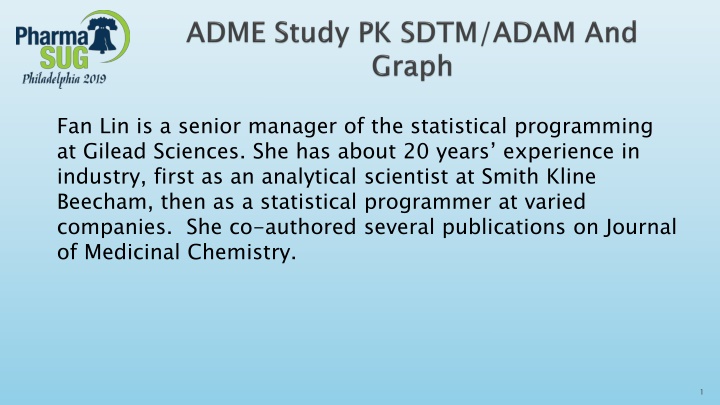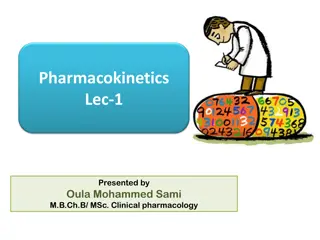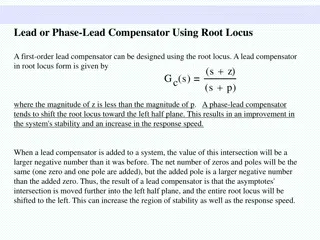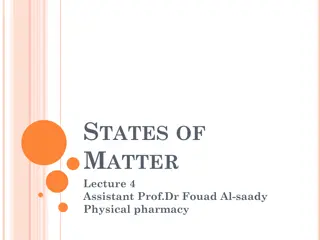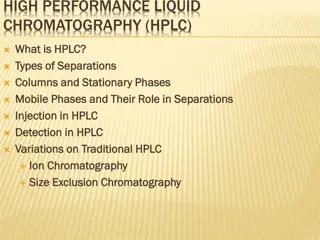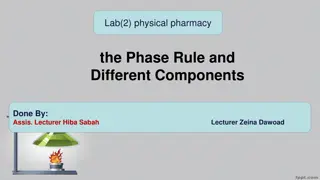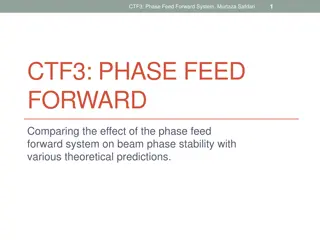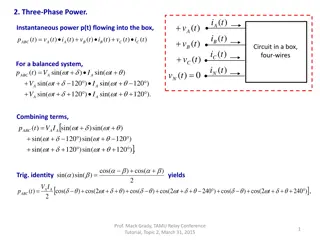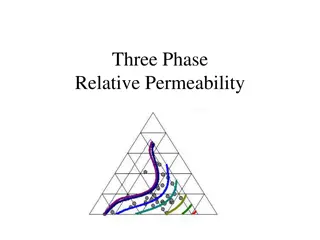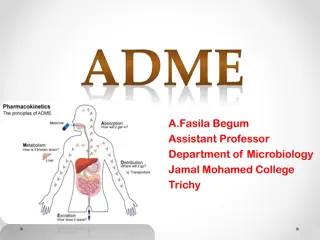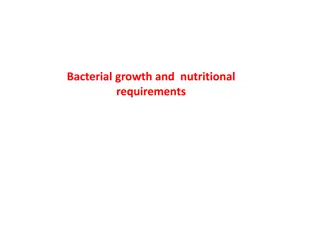Insights into ADME Phase I Studies
Fan Lin, a senior manager at Gilead Sciences, with extensive experience in industry, co-authored publications on Journal of Medicinal Chemistry. This content delves into the basics of pharmacokinetics, challenges in ADME PK studies, and the different categories of phase I study designs. It covers the goals, safety investigation, and processes involved in Phase I studies, emphasizing healthy subject participation, radio-labeled drug administration, and data collection methods like blood, plasma, urine, and feces analysis.
Download Presentation

Please find below an Image/Link to download the presentation.
The content on the website is provided AS IS for your information and personal use only. It may not be sold, licensed, or shared on other websites without obtaining consent from the author.If you encounter any issues during the download, it is possible that the publisher has removed the file from their server.
You are allowed to download the files provided on this website for personal or commercial use, subject to the condition that they are used lawfully. All files are the property of their respective owners.
The content on the website is provided AS IS for your information and personal use only. It may not be sold, licensed, or shared on other websites without obtaining consent from the author.
E N D
Presentation Transcript
Fan Lin is a senior manager of the statistical programming at Gilead Sciences. She has about 20 years experience in industry, first as an analytical scientist at Smith Kline Beecham, then as a statistical programmer at varied companies. She co-authored several publications on Journal of Medicinal Chemistry. 1
Introduction: oWhat is ADME? oWhat is ADME Phase I study? oThe challenges in ADME PK study Details: oADME study PK process oSteps of resolving the challenges in ADME PK study Summary
Pharmacokinetics Basics Absorption, Distribution, Metabolism and Excretion The figure is taken from PK/DB Database for Pharmacokinetic Properties IFSC/USP (URL= http://miro.ifsc.usp.br/pkdb/) accessed April 09, 2011 4
Phase I studies are usually conducted on healthy subjects Different categories of study designs are facilitated to achieve phase I study goals FIH Non-FIH SAD MAD SAD/MAD PK/PD Drug/Drug Interaction (DDI) Food Effect (FE) Bioavailability (BA) Bioequivalence (BE) Dose Proportionality DDI FE Mass Balance (ADME) PK/PD Steady-state QT 5
Phase 1 Phase 1 To investigate the safety, tolerability and PK/PD of the investigational drug in healthy subjects Mass balance, to obtain metabolism and excretion of the drug in humans Usually C14-lableled, conducted as part of clinical development of a drug ADME ADME A single dose administration of radio labeled drug in 6-8 healthy male subjects To access balance, measuring recovery of administered 14C-labeled compound from collected urine, feces and plasma Design Design 6
Sample Species PK Tests CRF Data cumulative amount of excrete cumulative percent of dose administration Derived records to carry over last available result Blood Plasma Plasma: Blood Urine Feces Derived Urine+Feces Derived cumulative time points 7
In Sample Species: Derived DTYPE=SUM to add urine and feces species The LOCF imputation technique was applied in cumulative tests. In PK tests: CRF data time points, 0 to each end time point, was derived in order to merge with concentration file for cumulative time points In CRF Data: 8
The work flow from receiving PK concentration file to generating reports in scheme A summary of the process The components of the ADME study PK data 10
PK concentration-time profiles are received from Bioanalytical Lab PKMERGE is created using actual sample collection date/time and demographic information from CRF and concentration data from BA lab for Plasma, Whole Blood, Urine and Feces PKMERGE is used for PK parameter generation by Clinical Pharmacology group and also as a source for PC PK parameters are calculated using specific software for non-compartmental analysis, such as SAS or WinNonlin, and used as source for SDTM PP dataset ADSL is updated to contain the PK population flag variables ADPC and ADPP ADaM datasets are generated by following ADaM IG PK concentration TFLs are generated from the ADPC and PK parameter outputs are generated from ADPP 12
Two components in ADME PK: regular cold PK and radio activity PK 13
Step1: Creation of PKMERGE Step2: Creation of SDTM Datasets Step3: Creation of ADaM Datasets Last Step: Generating Outputs 14
Concentration-time profiles are reviewed WNLCONCN-Sample Concentration Value (WNL): LOCF values kept for PK scientist to review L O C F 15
PKMERGE is created WNLCONCN: BLQs, 0 before first quantifiable concentration, missing after first quantifiable concentration Actual scheduled end date/time is calculated for interval time points deviation times(ENDEV) from actual to scheduled are calculated Served as rawdata to sdtm pc and also as source file provided to PK scientist for PK parameter 16
Important variables in PC and PP PK parameter PC domain: one record per analyte per planned time point per time point reference per visit per subject PP domain: one record per PK parameter per time-concentration profile per modeling method per subject 17
Urine, Plasma and Blood Species: PK parameter calculated values 19
DTYPE 1) LOCF The reason of N.S was kept in sample comment variable Subject discharged on Day 14 LOCF performed after Day 13 20
Urine time points are different DTYPE 2) SUM: handling timepoints Derived in urine and feces o Calculate first four urine intervals sum result as 0 to 24 hr o Sum of 24 to 36 and 36 to 48 hr in Urine as 24 to 48 hr o Now urine and feces have the same intervals o Adding values in urine and feces 21
DTYPE 2) SUM: handling no results available Sum is set to N.S. When both urine and feces has N.S. Sum is set to BLQ When both urine and feces has BLQ Sum is set to N.S. When one has BLQ the other has N.S. 22
Species Analysis Visit Time point Reason Result DTYPE=SUM No sample available after Day 13 due to subject discharged DTYPE=SUMLOCF LOCF was performed on N.S. records, after Day 13 23
Standard PK Outputs Tables: Include both listing and summary statistics Figures: PK concentration vs time profile includes individual plot and mean(SD)/median(Q1/Q3) plot Challenge Outputs Mean(SD) Cumulative Percent Dose Plot 1) Plot three lines: urine, feces and urine+feces 2) LOCF values were displayed on the plot 3) The number of actual subjects at each visit was presented at the bottom outside the plot area 24
layout lattice / rows=2 rowweights=(0.9 2 0.08) LOCF values were plotted Layout overlay/ ; blockplot x=visit block=n endlayout ; DiscreteLegend "series" / title=" " halign=left VALIGN=top exclude=(" -") Actual number of subjects remained To display No. of Subjects row: 1) create a missing category for it 2) in legend statement exclude this missing category 25
ADME PK study is a single dose study design Radioactivity PK brings more challenges The focus of this presentation describes the process flow of ADME PK study, PKMERGE, SDTM, ADaM and PK outputs The solutions to the challenges were provided The process described in earlier slides meets industry standard 27
PHUSE CSS Development of Standard Script for Analysis and Programming Working Group Analysis and Displays Associated to Non-Compartmental Pharmacokinetics With a Focus on Clinical Trials. Final Version1.0. 25 March 2014. Available https://phusewili.org/.../PHUSE CSS WhitePaper PK final 25March2014.pdf Lin, F. (2019). ADME Study PK SDTM/ADaM And Graph https://www.pharmasug.org/proceedings/2019/AD/PharmaSUG-2019- AD078.pdf 28
I would like to thank Gilead stat programming management team for their supports 29
Name: Fan Lin Organization: Gilead Sciences, Inc. Address: 333 Lakeside Drive City, State ZIP: Foster City, CA 94404 E-mail: Fan.Lin@gilead.com 30
